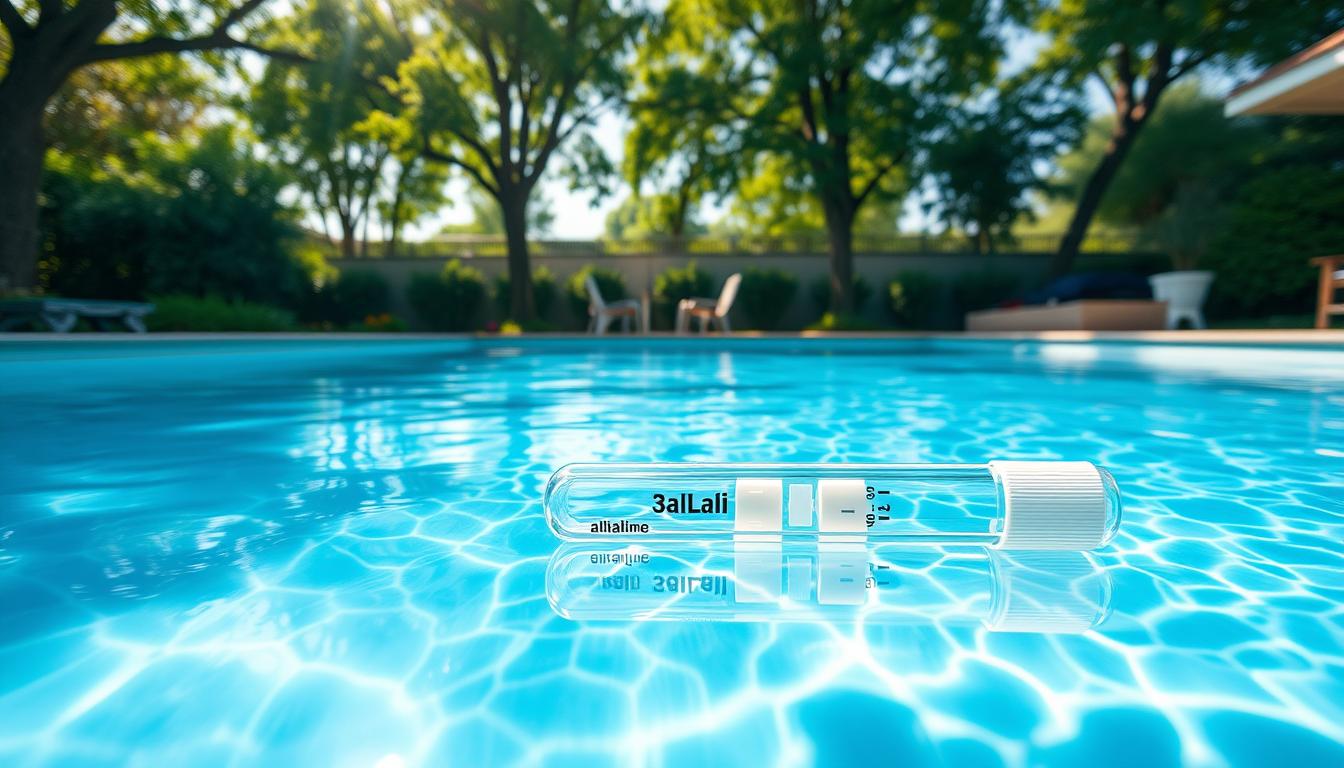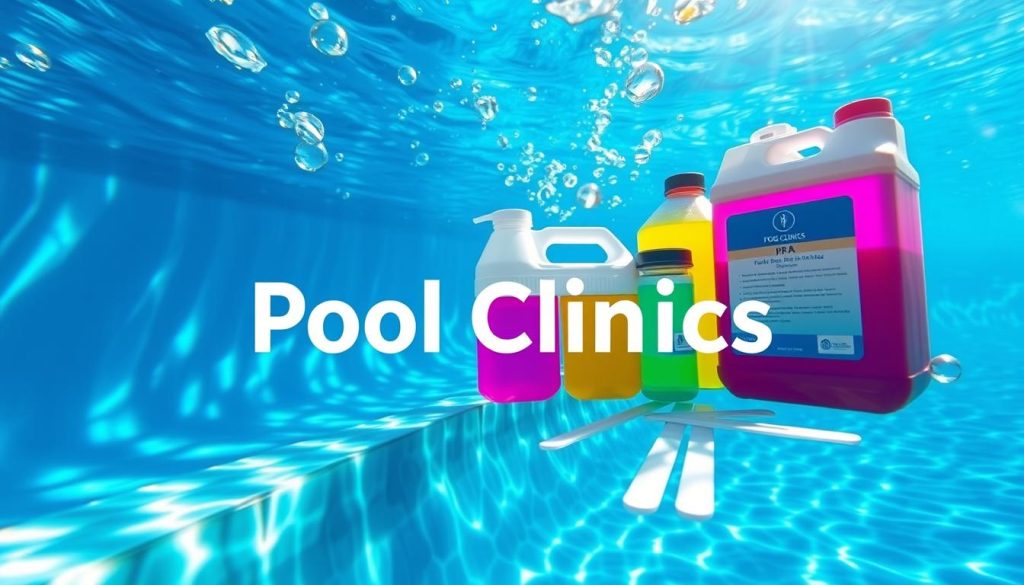
Creating a safe swimming environment is crucial for pool owners. Maintaining the right alkalinity levels is key to a healthy pool. Alkalinity prevents sudden pH changes that can harm swimmers and equipment.
The ideal pool alkalinity range ensures crystal-clear, balanced water. Let’s explore how to keep your pool’s alkalinity at the perfect level.
Key Takeaways
- Ideal pool alkalinity levels range from 80 to 120 ppm for most pools
- Alkalinity acts as a buffer, preventing drastic pH fluctuations
- Low alkalinity can lead to corrosion and swimmer discomfort
- High alkalinity causes cloudiness and scaling issues
- Regular alkalinity testing and adjustment is essential for pool maintenance
Understanding Pool Alkalinity
Alkalinity plays a vital role in pool water chemistry. It helps stabilize pH levels and prevents sudden changes. This balance ensures swimmer comfort and protects pool equipment.
Maintaining the right alkalinity is key to a healthy swimming environment. It affects water quality, swimmer safety, and equipment longevity.

What is Alkalinity in Pools?
Alkalinity measures water’s ability to neutralize acids and keep pH stable. In pools, total alkalinity (TA) refers to alkaline substances in the water.
These substances include carbonates, bicarbonates, and hydroxides. They act as buffers, resisting pH changes when acids or bases enter the pool.
A well-balanced pool should have a total alkalinity level between 80 and 120 parts per million (ppm), with the ideal range being 100-120 ppm.
The Importance of Maintaining Proper Alkalinity Levels
Proper alkalinity levels are crucial for several reasons:
- pH stability: Proper alkalinity keeps pH levels steady. This prevents skin irritation and damage to pool surfaces and equipment.
- Water clarity: Balanced alkalinity allows pool sanitizers to work effectively. This helps prevent cloudy water.
- Equipment longevity: Correct alkalinity levels extend pool equipment life. They prevent corrosion and scale buildup on pumps, filters, and heating systems.
| Pool Surface Type | Ideal Alkalinity Range (ppm) | Potential Issues |
|---|---|---|
| Gunite | 80-120 | Corrosion, deterioration, discoloration |
| Fiberglass | 80-120 | Etching, gel coat corrosion |
| Vinyl Liner | 80-120 | Discoloration, faster deterioration |
Regular testing and balancing are essential for proper pool maintenance. These practices ensure a safe and comfortable swimming environment.
By managing alkalinity, you protect your pool and enhance the swimming experience. Your family and friends can enjoy a clean, safe pool for years to come.
The Ideal Alkalinity Range for Pools
Proper pool alkalinity is vital for safe swimming. The ideal range is 80 to 120 parts per million (ppm). This creates a stable environment for effective sanitization and prevents issues from imbalanced levels.
Recommended Alkalinity Levels
Experts recommend 80 to 120 ppm for pool alkalinity. This range buffers water against sudden pH changes. Factors like rain, swimmers, and chemicals can affect pH levels.
Maintaining this range ensures stable and well-balanced pool water. It helps create a comfortable swimming environment for all users.
The recommended dosage to raise a pool’s alkalinity is 1.5 pounds of sodium bicarbonate per 10,000 gallons of water.
To estimate your pool’s water volume, use this formula:
- Average Width x Average Length x Average Depth x 7.5
Consequences of Low and High Alkalinity
Alkalinity levels outside the recommended range can cause problems. These issues affect water quality, equipment, and swimmer comfort.
Low alkalinity effects include:
- Chlorine inefficiency
- Metal corrosion
- Pool staining
- Scale formation
High alkalinity effects can cause:
- Reduced pool circulation
- Clogged filters
- Rough surfaces
Regular water testing is crucial to maintain proper alkalinity. Add muriatic acid or sodium bisulfate to lower alkalinity. Use sodium bicarbonate (baking soda) to raise it.
| Alkalinity Level | Effects on Pool Water |
|---|---|
| Too Low ( | Chlorine inefficiency, metal corrosion, pool staining, scale formation |
| Just Right (80-120 ppm) | Stable pH levels, effective sanitization, comfortable swimming experience |
| Too High (> 120 ppm) | Reduced pool circulation, clogged filters, rough surfaces |
What Should Alkalinity Be in Pool?
Experts suggest keeping pool alkalinity between 100 and 150 parts per million (ppm). This range helps prevent pH fluctuations and ensures a clean swimming environment. Proper alkalinity allows chlorine to effectively kill bacteria and viruses.
Test the water regularly when adjusting pool alkalinity. Make small changes to avoid overcorrection. For low alkalinity, add sodium bicarbonate or soda ash to increase levels.
To lower high alkalinity, add muriatic acid or dry acid to the water. Always follow the manufacturer’s instructions when handling pool chemicals.
Always follow the manufacturer’s instructions and handle pool chemicals with care to ensure safe and effective alkalinity adjustments.
After adjusting alkalinity, let the water circulate for 6-8 hours before retesting. Repeat if needed to reach 100-150 ppm. Regular maintenance keeps alkalinity levels stable for safe swimming.
| Alkalinity Level | Adjustment Method |
|---|---|
| Low (below 100 ppm) | Add sodium bicarbonate or soda ash |
| High (above 150 ppm) | Add muriatic acid or dry acid |
Proper alkalinity keeps pool water balanced, clear, and comfortable. It enhances the swimming experience and protects pool equipment. Balanced water chemistry prevents damage to surfaces and extends the life of your pool.
Conclusion
Proper pool alkalinity is vital for a healthy swimming environment. The ideal range is 80-120 ppm, which stabilizes pH levels. This prevents corrosion, scaling, and irritation, ensuring a clean and comfortable pool.
Regular testing and adjusting of alkalinity levels are crucial. Using the right chemicals helps maintain the proper range. This approach extends pool equipment life and improves the swimming experience.
Pool owners should prioritize alkalinity maintenance. Consistent care ensures safety and comfort for all swimmers. A well-maintained pool with proper alkalinity leads to enjoyable summer memories.







